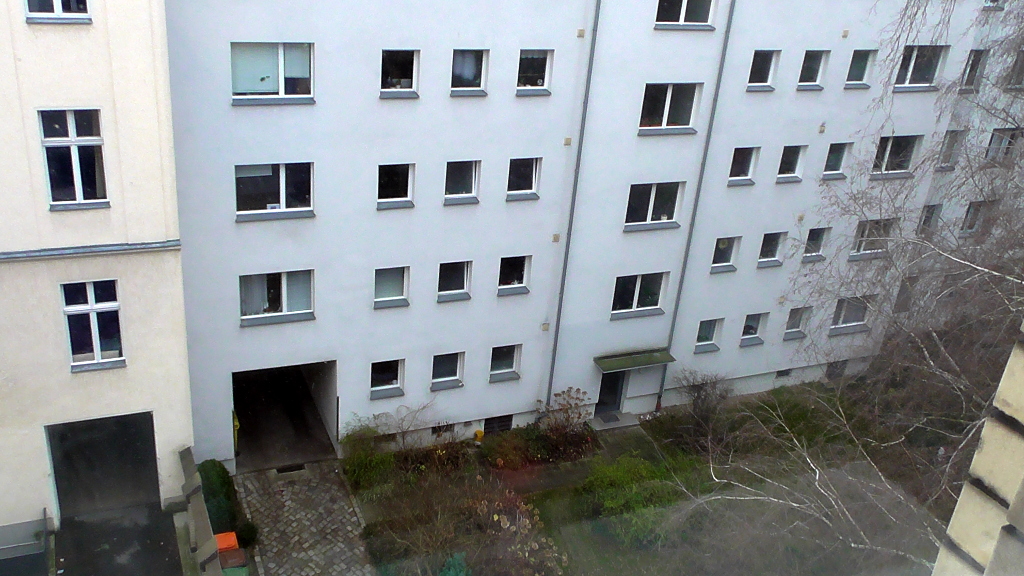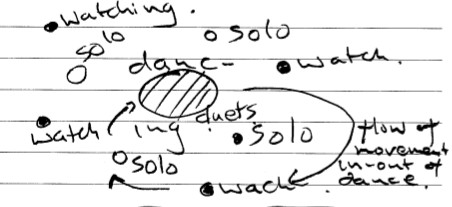This is the fourth day of a five day winter intensive with Joerg Hassmann.
What is the relationship between our neck and our centre (where our centre is located just below our belly button)? We start by studying this while an artist draws our feet.
We lie on the floor and put a cushion under our centre with our head and neck hanging. We explore the possibilities by shifting our weight and position. Joerg shows a position with the head extended and looking up saying to us that ‘babies do this’ and then they release their head. It’s an inquisitive look.
A jam follows with lots of floor work and gentle movement.

Table
It’s a very familiar form for all of us who’ve danced contact: table – kneeing on the floor with our hands on the floor too, and presenting our back as a horizontal surface on which to dance. Our table work – with a partner – consists of examining entry into or onto this table structure:
- One partner sits on the ground with their back to the other dance partner who approaches them from behind and who contacts their belly with the back of the other dancer. There’s also contact in the thighs and the underarm of the person behind which increases stability and connection between the dancers. The sitting dancer then moves into table with the other dancer remaining at their back as it moves from vertical in sitting, to horizontal in table. So, it’s belly [of the over-dancer] to back [of under-dancer]!
- Next, we consider a dancer who is in table position, and the other dancer positions themselves to their side. They sit and slide on the back of their partner until their back is in contact with the back of their partner whose in table. So, for this exercise then its back [of the over-dancer] to back [of under-dancer]!
We study the latter of these in the context of Goat Shepherd movement – and Joerg emphasises the importance of sliding on the table partner to successfully achieve the manoeuvre.
Head
The head can lead a movment but our partner can also lead our head setting up rotations in our spine and pelvis.
We work with partners and I partner with Joerg. One partner compresses the others head! Both partners are seated on the ground. We start with the head on the thigh of their partner. The legs are used to compress the head and to give it support, and the hands can also be used to aid freedom of movement. We can roll the head too using open hands; and also slide it. It’s quite intimate and I can’t imagine doing this in a jam. I am am too active and Joerg bids me to do less, noting that this is my pattern i.e. learned behavior. We swap roles and it leads to gentle jamming.
After lunch


We walk in the space and try a number of simple solo excercises:
- Find a person and move their skin! It’s skin level or surface work: push with your hand on the surface of their skin; clasp the skin by closing your hand around it; scrunch it up. Find another person and repeat.
- Tilt your head to the side and walk in that direction – a circular walk results. Now tilt your head to the other side and repeat. Everyone seems to then walk in the other direction. Finally, tilt your head to the other side and continue walking in the SAME direction as when your head was tilted the other side. It feels very odd! Perhaps we learn disorientation and normalise it.
- Hold you hands out in front of you with the thumbs extended – thumbs up! Now focus on the thumbs and bring them into your line of sight; and walk. Gradually move your thumbs apart while continuing to walk. Presumably, this exercise is about using the peripheral vision to move and navigate. In some martial arts, they say look through your opponent as if to the mountain. Perhaps it’s same idea although a martial art is combat rather than dance… but it’s still a movement practice.
Perch
If you put your hands together and intertwine the fingers then you have a ‘perch’ which can support, hold and lift a person. To be effective then you really need to have good contact with the person ‘perching’ on it which means intimate contact with the sitting bones. We stand and practice this with a partner. It reminds me of a movement which I saw in Rock and Roll (Ballroom dancing) where a person is lifted with this ‘perching’ contact point, and which you can see near the end of this You Tube video.
Barn Dance
Our jam session today, takes the form of a directed dance which Joerg describes at the beginning. Infact, it reminds me of community dances or barn dances since the dancing is directed.

The dancers can be in three states: watching; solo dancing; duet dancing. The dancers move between these states and the spaces where each part is performed. When watching then the dancers might react to the dancing which they see, being danced in solos or duets.
I join this dance but it was confusing. Part of the confusion is because the director – the teacher Joerg, is dancing and not an onlooker directing it and giving clear instructions. The dance becomes a dance of knowing and not knowing. Those that know, follow the dance directions implicitly, and those that don’t know, dance in a different way.
Later, at a feedback session then it’s said that it (the jamming session above) didn’t really work, and it certainly didn’t achieve the stated intention. But all contact improvisation is a research it’s said, and so unexpected and unsuccessful outcomes are good – that’s what research is all about!
Feet Artist
Through-out the week, artist Anne-Sophie Velten has been sitting-in and drawing the feet of the dancers. She showed her sketchbook and explained the project. Please note that the camera work is shaky at first but soon settles down!
Read the diary entry for the next day of the intensive (day 5)
Read the diary entry for the previous day of the intensive (day 3)
